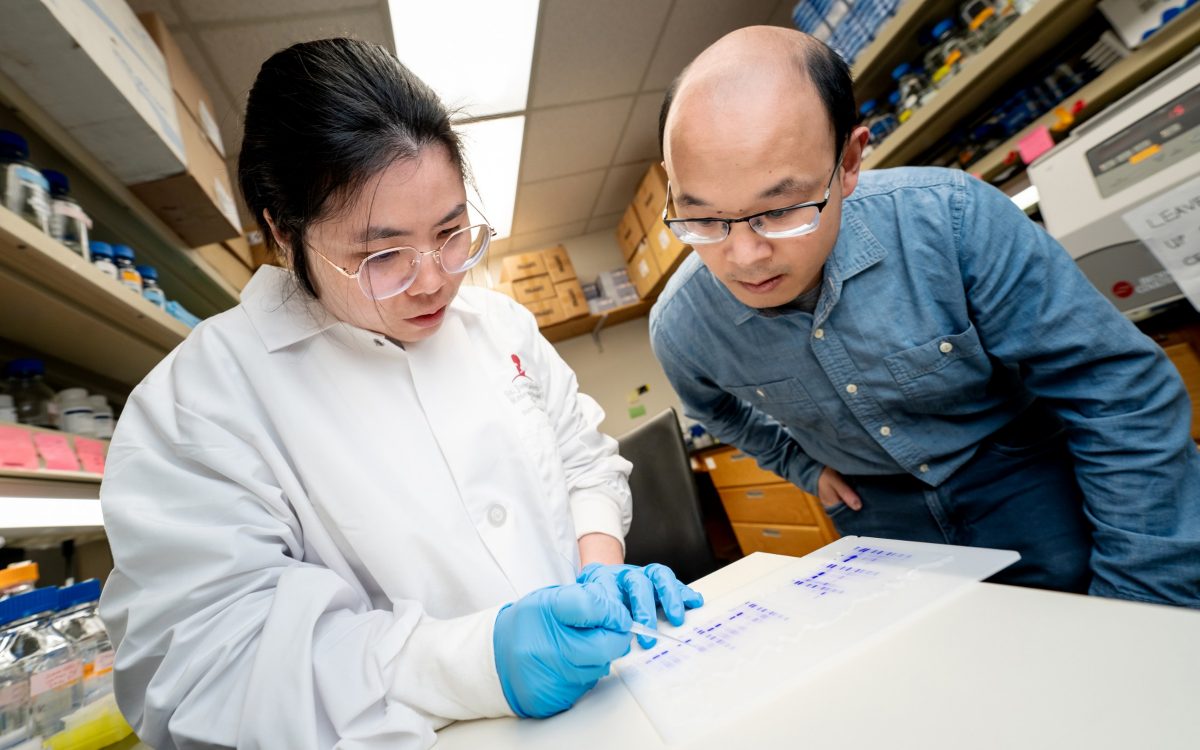
First author Meiqin Jiang, Ph.D., and co-corresponding author Ji Sun, Ph.D., St. Jude Department of Structural Biology.
St. Jude Children's Research Hospital scientists solved the 3D structure of a major protein complex in cilia, signaling appendages found on cells. The structure was captured at the highest resolution to date. The work serves as a foundation to study diseases of the brain, kidney, skeleton and eyes that are known to involve cilia but were difficult to investigate. The findings were published today in Cell Research.
Cilia are hair-like projections found on nearly all mammalian cells that control many signaling processes. The cilium is a type of thin tube that lacks the machinery to synthesize the proteins needed for cell signaling. Therefore, the signaling molecules inside cilia must be brought over from other areas in the cell. Intraflagellar transport complexes, called IFT-A and IFT-B, serve as trains that bring proteins to and from cilia.
For over a decade, scientists have attempted to understand the structure of the IFT-A and -B complexes. The St. Jude scientists determined the structure of IFT-A to an overall resolution around 3-4 Angstroms, which allows us to visualize these complexes in near-atomic detail.
"Now that we have the high-resolution structure of this ciliary complex, we can map mutations known to cause diseases and then design clinical interventions," said co-corresponding author Ji Sun, Ph.D., St. Jude Department of Structural Biology. "We can tell at the atomic level tell how these trains assemble with each other to form very elegant structures in the cilia. We can also use that knowledge to understand how disease mutations disrupt that structure."
Their work reveals new details that were never clear enough to understand in previous attempts. For example, they revealed previously unknown zinc-binding sites in IFT-A. Zinc-binding sites are important to a type of protein domain called zinc fingers. Zinc fingers are critical for certain protein-protein interactions, which explained some poorly understood connections within the train complex.
"It was pretty exciting to see the zinc fingers because no one had seen or even predicted zinc-binding sites in IFT-A," Sun said. "Our study was able to reveal that with confidence. We could say, 'Hey, there's zinc, and it is important for protein-protein interaction, which might also facilitate train assembly.' We never would have figured that out without our high-resolution structural information."
A molecular ticket to ride
Though important, the train is only part of the story. The scientists were able to solve the structure of IFT-A in complex with the protein Tubby-related protein 3 (TULP3).
"To ride a train, you need a ticket. TULP3 is a ticket to get on the train of IFT-A," said Sun. "TULP3 can then recognize different acceptable cargo to be transported on the train. So, when you have molecular cargo that can hold onto this ticket, it can ride the train. If you disrupt this TULP3 interaction, then you can no longer transport certain cargos, because they lack a valid molecular ticket."
Finding the 3D structure of TULP3 and IFT-A in complex is a major accomplishment that will give insight into how signaling molecules move to and from cilia, and how disruption in the interface between the two can cause disease.

Understanding diseases of cilia at a high resolution
Cilia are important organelles across many species. This high conservation across species tells scientists that cilia are important. Many mutations in ciliary proteins are associated with diseases of different tissues. However, without a structure, it is difficult to rationalize how changes in the proteins cause disease. Therefore, scientists have made many attempts to solve the structure of ciliary components in the past decade. The St. Jude group has succeeded in producing a structure of IFT-A at a high resolution using a method known as single-particle electron cryo-microscopy (cryo-EM).
"The field has been waiting a long time to see these complexes," Sun said. "IFT-A is a complex of six proteins. We know that IFT-A mutations affect skeletal development, especially the ribs, but also structures like the retina. There are many developmental diseases caused by mutations in this complex."
Combined, the high-resolution structures of IFT-A and TULP3 in complex can now serve as the basis of investigation for many developmental diseases involving cilia and help guide the creation of novel approaches to mitigate or cure them.
Authors and funding
The study's first author is Meiqin Jiang, of St. Jude. The other authors are Darcie Miller, Hanwen Zhu and Patricia Hixson, all of St. Jude; and Vivek Reddy Palicharla, Sun-Hee Hwang and Saikat Mukhopadhyay, University of Texas Southwestern Medical Center.
The study was supported by the St. Jude cryo-EM center and by grants from the National Institutes of Health (R00HL143037, R35GM144136 and 1S10OD028630) and ALSAC, the fundraising and awareness organization of St. Jude.
Read the full text of the Cell Research article:
Human IFT-A complex structures provide molecular insights into ciliary transport
Cell Research, published February 13, 2023






